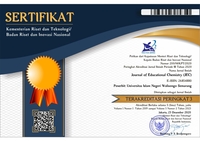Misconceptions About Buffer Solutions
DOI:
https://doi.org/10.21580/jec.2022.4.2.12687Keywords:
chemistry, buffer solution, misconceptionAbstract
There are many misconceptions in the chemistry discussion that can influence students to acquire new knowledge, one of which is regarding buffer solutions. It is one of the chemical concepts consisting of abstract ideas which likely trigger students' misconceptions. However, research on this topic was still limited. Thus, in the present study, researchers attempted to diagnose students' misconceptions about buffer solutions by administering a two-tier multiple-choice test. Research data were analyzed qualitatively and quantitatively. Respondents in this study were 98 second-semester eleventh-grade students majoring in Science in 3 senior high schools, with high (A), moderate (B), and poor (C) categories based on the 2015 National Examination's scores. The misconceptions detected were about what buffers do, what buffers are, and how buffers can do what they do. These findings were discovered in schools with a moderate category.
Downloads
References
Barke H D, H. A. 2009. Misconceptions in chemistry: Addressing Perceptions. Heidelberg: Springer - Verlag.
Chandrasegaran, A. L., Treagust, D. F., & Mocerino, M. 2007. The Development of a Two-Tier Multiple-Choice Diagnostic Instrument for Evaluating Secondary School Students’ Ability to Describe And Explain Chemical Reactions Using Multiple Levels of Representation. Chemistry Education Research and Practice, 8(3), 293–307. https://doi.org/10.1039/B7RP90006F
Drastisianti, A., Susilaningsih, E., Supartono, M., & Wijayati, N. 2018. The Study of Chemistry Learning on The Material of Buffer Solution Supported by Teaching Material of Multiple Representation-Chemoentrepreneurship Viewed From Student Entrepreneurship Interest. Advances in Social Science, Education and Humanities Research: Proceedings of the International Conference on Science and Education and Technology 2018 (ISET 2018), 27–31. https://doi.org/10.2991/iset-18.2018.6
Drastisianti, A., Wijayati, N., & Susilaningsih, E. 2018. Identification of Misconceptions on Buffer Material Using Three-Tier Test in the Learning of Multiple Representation. Journal of Innovative Science Education, 7(1), 95–100.
Fadillah, A., & Salirawati, D. 2018. Analysis of Misconceptions Of Chemical Bonding Among Tenth Grade Senior High School Students Using a Two-Tier Test. AIP Conference Proceedings, 2021 (October 2018), 080002. https://doi.org/10.1063/1.5062821
Gani, A., Safitri, R., & Mahyana, M. 2017. Improving The Visual-Spatial Intelligence and Results of Learning of Juniour High School Students’ with Multiple Intelligences-Based Students Worksheet Learning on Lens Materials. Jurnal Pendidikan IPA Indonesia, 6(1), 16–22. https://doi.org/10.15294/jpii.v6i1.9594
Hanson, R. 2019. The Impact of Two-tier Instruments on Undergraduate Chemistry Teacher Trainees: An Illuminative Assessment. International Journal for Infonomics, 12(4), 1920–1928. https://doi.org/10.20533/iji.1742.4712.2019.0198
Johnstone, A. H. 2000. Teaching of Chemistry - Logical or Psychological?. Chem. Educ. Res. Pract., 1(1), 9–15. https://doi.org/10.1039/a9rp90001b
Kusumaningrum, I. A., Ashadi, & Indriyanti, N. Y. 2018. Concept Cartoons for Diagnosing Student’s Misconceptions in The Topic of Buffers. Journal of Physics: Conference Series, 1022(1). https://doi.org/10.1088/1742-6596/1022/1/012036
Mufit, F., Festiyed, F., Fauzan, A., & Lufri, L. 2018. Impact of Learning Model Based on Cognitive Conflict toward Student’s Conceptual Understanding. IOP Conference Series: Materials Science and Engineering, 335(1). https://doi.org/10.1088/1757-899X/335/1/012072
Mutlu, A., & Şeşen, B. A. 2016. Evaluating of Preservice Science Teachers’ Understanding DF General Chemistry Concepts by Using Two Tier Diagnostic Test. Journal of Baltic Science Education, 15(1), 79–96. https://doi.org/10.33225/jbse/16.15.79
Orgill, M. K., & Sutherland, A. 2008. Undergraduate Chemistry Students’ Perceptions of and Misconceptions About Buffers and Buffer Problems. Chemistry Education Research and Practice, 9(2), 131–143. https://doi.org/10.1039/b806229n
Rahmawan, S., Firman, H., Siswaningsih, W., & Rahayu, D. S. 2021. Development of Pictorial-based Two-Tier Multiple Choice Misconception Diagnostic Test on Buffer Solutions. JTK (Jurnal Tadris Kimiya), 6(2), 132–143. https://doi.org/10.15575/jtk.v6i2.13219
Salirawati, D. 2013. Pengembangan Instrumen Pendeteksi Miskonsepsi Kesetimbangan Kimia pada Peserta Didik SMA. Jurnal Penelitian Dan Evaluasi Pendidikan, 15(2), 232–249. https://doi.org/10.21831/pep.v15i2.1095
Septian, I. D., Susilaningsih, E., & Sumarti, S. S. 2020. Misconception Analysis of Buffer Material using Three Tier Multiple Choice Test assisted by CBT for SMAN 9 Semarang. Journal of Innovative Science Education, 9(1), 40–49.
Siswaningsih, W., Nahadi, & Widasmara, R. 2019. Development of Three Tier Multiple Choice Diagnostic Test to Assess Students’ Misconception of Chemical Equilibrium. Journal of Physics: Conference Series, 1280(3), 5–10. https://doi.org/10.1088/1742-6596/1280/3/032019
Soeharto, Csapó, B., Sarimanah, E., Dewi, F. I., & Sabri, T. 2019. A Review of Students’ Common Misconceptions in Science and Their Diagnostic Assessment Tools. Jurnal Pendidikan IPA Indonesia, 8(2), 247–266. https://doi.org/10.15294/jpii.v8i2.18649
Supatmi, S., Setiawan, A., Rahmawati, Y., Education, C., Program, S., & Jakarta, U. N. 2019. Students’ Misconceptions of Acid-Base Titration Assessments using a Two - Tier Multiple-Choice Diagnostic Test. African Journal of Chemical Education, 9(1), 18–37.
Üce, M., & Ceyhan, İ. 2019. Misconception in Chemistry Education and Practices to Eliminate Them: Literature Analysis. Journal of Education and Training Studies, 7(3), 202. https://doi.org/10.11114/jets.v7i3.3990
Ulfah, L., Kusasi, M., & Almubarak, A. 2021. Reduction of Student Misconceptions: Application of Ttw-Pbl Learning With Chemical Representation on Buffer Solution Materials. Jurnal Pena Sains, 8(2), 48–57. https://doi.org/10.21107/jps.v8i2.8610
Downloads
Published
How to Cite
Issue
Section
License
The copyright of the received article shall be assigned to the journal as the publisher of the journal. The intended copyright includes the right to publish the article in various forms (including reprints). The journal maintains the publishing rights to the published articles.
Authors are permitted to disseminate published articles by sharing the link/DOI of the article at the journal. Authors are allowed to use their articles for any legal purposes deemed necessary without written permission from the journal with an acknowledgment of initial publication to this journal.

This work is licensed under a Creative Commons Attribution-NonCommercial-ShareAlike 4.0 International License.


